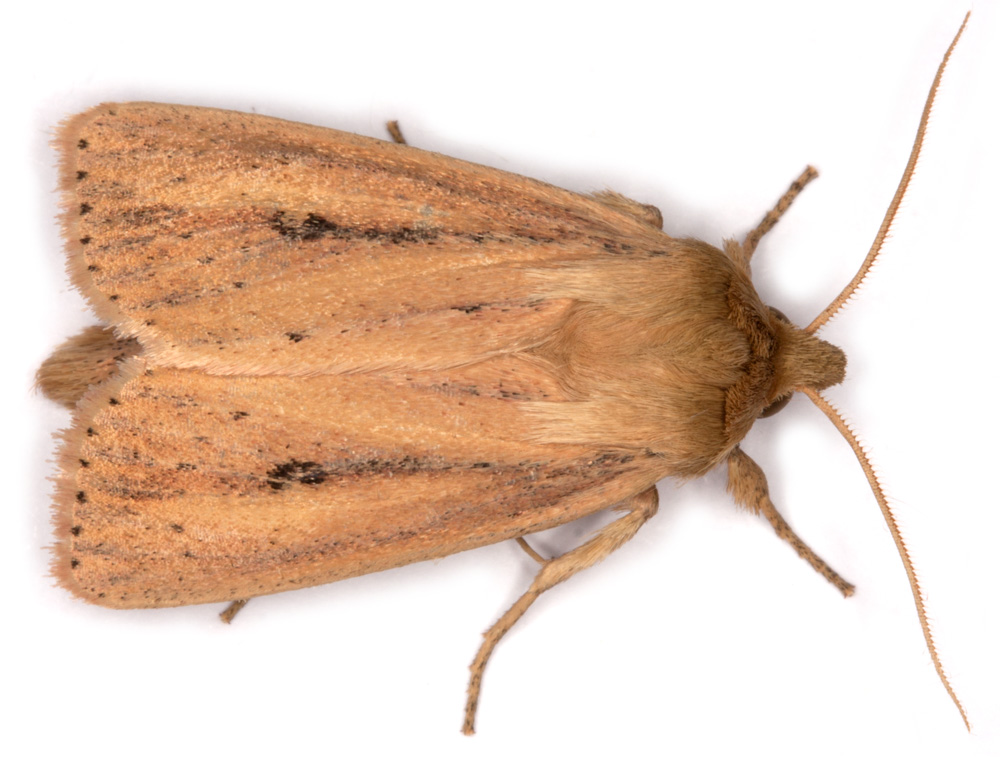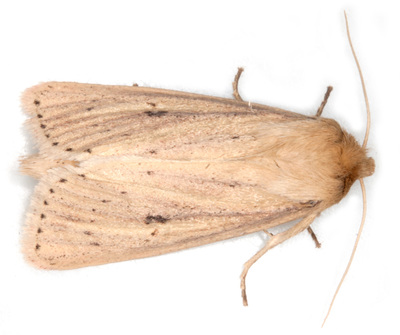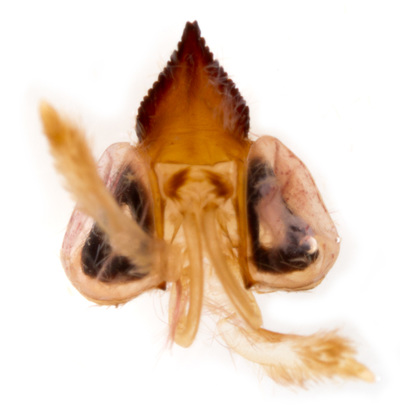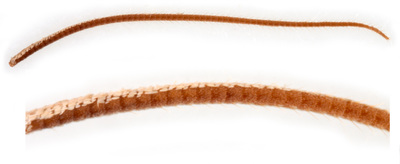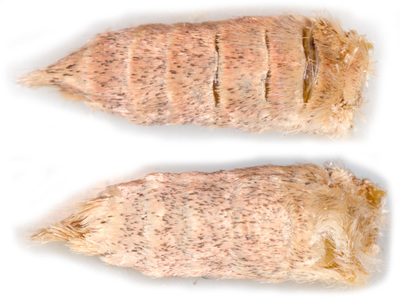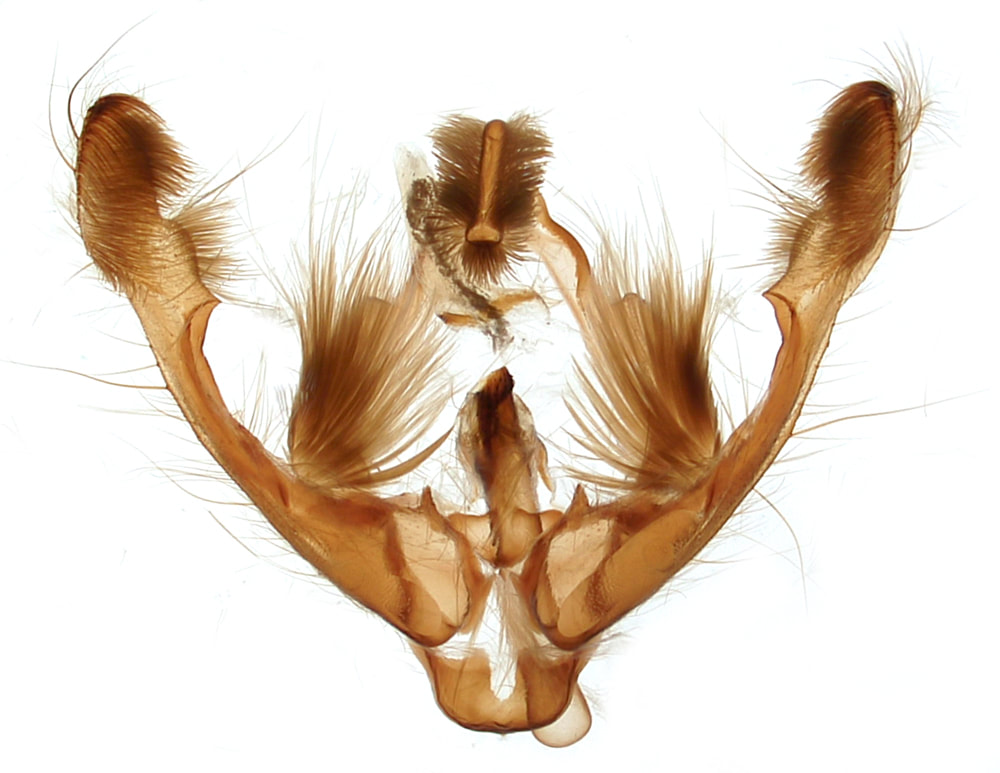73.151 Globia sparganii (Webb's Wainscot)
fw: 15-18mm (Waring & Townsend), ws 34-44mm (MBGBI10); Aug-Oct; bulrush/lesser bulrush (Typha latifolia/angustifolia), yellow iris (Iris pseudacorus), common club-rush (Schoenoplectus lacustris), branched bur-reed (Sparganium erectum); NS-B south coast of England, east coast north to Lincolnshire, north coast of Somerset, south coast of Wales, increasing inland in SC & SE.England.
Synonyms: Archanara sparganii (Waring & Townsend, MBGBI10), Nonagria sparganii (Pierce [males]), Gortyna sparganii (Pierce [females])
Pierce suggested that the two current Globia species warranted separate generic placement, due to the "curious formation of the ovipositor" - his advice seems to have been followed - albeit 70 years later!
Synonyms: Archanara sparganii (Waring & Townsend, MBGBI10), Nonagria sparganii (Pierce [males]), Gortyna sparganii (Pierce [females])
Pierce suggested that the two current Globia species warranted separate generic placement, due to the "curious formation of the ovipositor" - his advice seems to have been followed - albeit 70 years later!
ID: Forewing ground colour varies from cream to orange; curved postmedian line of black dots; kidney mark white ringed black; black central basal streak passes through kidney mark; black terminal line of dots; hindwing often streaked; abdomen extends beyond tornus at rest. Antenna: male - fasciculate, bisetose, the setae long and curved; female - finely bisetose.
G.algae (Rush Wainscot) lacks the black terminal row of spots, has a black kidney mark and the abdomen doesn’t extend beyond the tornus at rest. Nonagria typhae (Bulrush Wainscot) is larger (fw: 20-24mm), lacks a distinct kindey mark and lacks a postmedian row of dots.
Archanara dissoluta (Brown-veined Wainscot) can be very similarly marked but is smaller (fw 12-15mm), it usually lacks a distinct postmedian row of dots and the terminal interneural markings are more like crescents that dots - where these are well-marked the veins are dark-lined (in my experience in G.sparganii the veins are usually paler than the ground colour).
G.algae (Rush Wainscot) lacks the black terminal row of spots, has a black kidney mark and the abdomen doesn’t extend beyond the tornus at rest. Nonagria typhae (Bulrush Wainscot) is larger (fw: 20-24mm), lacks a distinct kindey mark and lacks a postmedian row of dots.
Archanara dissoluta (Brown-veined Wainscot) can be very similarly marked but is smaller (fw 12-15mm), it usually lacks a distinct postmedian row of dots and the terminal interneural markings are more like crescents that dots - where these are well-marked the veins are dark-lined (in my experience in G.sparganii the veins are usually paler than the ground colour).
§1 Foulness, Essex; 06/09/2008; male; fw 18.7mm
§2 Surlingham, Norfolk; 23/07/2009; male; fw 16.0mm
§3 Ham Fen, Kent; 09/08/2010; male; fw 17.5mm
§4 Strumpshaw Fen, Norfolk; 07/09/2011; female; fw 20.8mm
§5 Strumpshaw Fen, Norfolk; 22/08/2012; female; fw 18.6mm
§6 Westwood Marsh, Suffolk; 11/08/2015; male; fw 15.1mm
§7 Foulness, Essex; 21/07/2018; female; fw 19.0mm
§8 St Mary's, Isles of Scilly; 22/08/2022; female
§9 Foulness, Essex; 13/08/2022; male; fw 17.2mm
All images © Chris Lewis
§2 Surlingham, Norfolk; 23/07/2009; male; fw 16.0mm
§3 Ham Fen, Kent; 09/08/2010; male; fw 17.5mm
§4 Strumpshaw Fen, Norfolk; 07/09/2011; female; fw 20.8mm
§5 Strumpshaw Fen, Norfolk; 22/08/2012; female; fw 18.6mm
§6 Westwood Marsh, Suffolk; 11/08/2015; male; fw 15.1mm
§7 Foulness, Essex; 21/07/2018; female; fw 19.0mm
§8 St Mary's, Isles of Scilly; 22/08/2022; female
§9 Foulness, Essex; 13/08/2022; male; fw 17.2mm
All images © Chris Lewis
Page published 13/03/2016 (§1-6) | §7 added 29/04/2019 | §8 added 02/12/2022 | §9 added 23/12/2022
